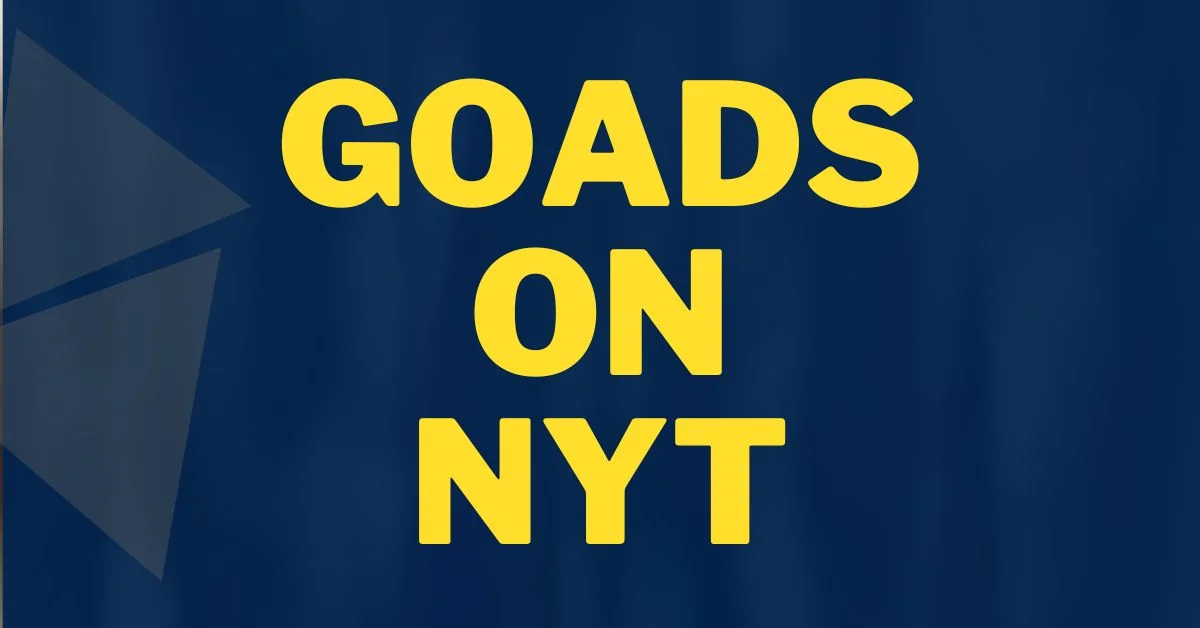Introduction: Understanding the Goads on NYT Controversy
In journalism, controversy meets ethics, and editorial integrity is brought to light by scrutiny. Welcome to the eye of the storm. Reputably for its journalism, the New York Times (NYT) is embroiled in contentious discussions over its reporting guidelines and methods. Introducing the realm of Goads on NYT — a divisive subject that has sparked debates, split views, and called into question the fundamental nature of media power. Let’s explore this fascinating story that takes place inside the halls of one of the most esteemed journalistic organizations in the world.
Background: The Origins and Context of Goads on NYT
The Goads on NYT debate sprang from a pervasive mistrust of established media sources. First appearing in the era of digital information, when anybody may produce material, criticism of reputable news media like The New York Times has grown. Critics question journalistic honesty and prejudices in mainstream reporting.
The Goads on NYT argument represents a more significant change in how society views and absorbs news. Long-standing institutions are under more examination as social media magnifies voices of disapproval and alternative stories gain popularity.
Understanding the beginnings of the Goads on NYT debate depends heavily on how journalism has developed. Audiences now more than ever want openness and responsibility from news organizations as lines between fact and opinion, truth and false information, haze.
Key Events Leading to the Goads on NYT Debate
When the Goads on NYT dispute emerged, the New York Times found itself at the center of controversy in the fast-changing media landscape. This contentious conversation began with scathing pieces written by well-known journalists who questioned the news organization’s editorial policies.
Social media sites became battlefields where supporters and detractors of NYT journalism standards expressed their views as hostilities increased. The newspaper’s answer to these charges fanned the flames even more, drawing closer examination from inside and outside the media.
Though critics’ concerns were addressed, debates about the Goads in the NYT incident remained dominated by impartiality, bias, and accountability issues. As those involved struggled with divergent viewpoints and interpretations of the events, it was evident that this argument would significantly impact journalism and the New York Times.
Essential Events that Preceded the NYT Debate Goads
The major incidents that preceded the Goads on NYT scandal resembled a sequence of seismic changes in the media environment. It started with an investigative piece by a well-known writer who exposed dubious procedures in the New York Times newsroom. After this revelation, there was much controversy over journalistic integrity in journalism circles.
As additional details surfaced, it became clear that one of the world’s best-known news organizations was dealing with serious problems. Conversations on bias and editing procedures took center stage, testing the public’s confidence in traditional media.
Social media sites heightened these exchanges, which spread throughout digital environments. Readers and business experts offered their opinions on how these disclosures might affect the NYT’s credibility and reputation.
The events as they were happening gave journalists everywhere a wake-up call about the value of responsibility and openness in reporting. The aftermath of these significant occasions is still felt in the journalistic community, leading to reflection and demands for higher moral standards.
Impact on Journalism: How Goads on NYT Has Shaped Media Practices
The goads on the NYT controversy have caused a stir in journalism, igniting debates on morality and journalistic standards. This event has forced news organizations to review their editorial procedures and openness requirements. Journalists are more aware of the value of extensive research and fact-checking before releasing news.
Moreover, the criticism the New York Times has received should teach other media companies about the fallout from inaccurate reporting or skewed stories. Journalists prioritize credibility over sensationalism as the public’s need for reliable news sources has grown.
One thing is sure when this debate blows over: journalism is changing. Media professionals are changing to keep up with the fast spread of false information and uphold more excellent responsibility standards. The jabs at the NYT have permanently changed how news is reported and absorbed in modern culture.
Public Reaction: Reader Responses to Goads on NYT
Readers worldwide were keen to share their thoughts as word of the goads on the NYT controversy leaked. The accusations shocked some, who questioned the reliability of a well-known newspaper like The New York Times. Others adopted a more critical position, urging the media to be held more responsible and transparent.
Social media sites erupted with hot debates on the effects of these disclosures on journalism in general. Many demanded more investigation of news sources and emphasized the need for moral reporting methods.
A few devoted New York Times readers supported their preferred publication, defending its standing and stressing the importance of impartiality in the face of sensationalized headlines. Conversely, detractors took advantage of this opportunity to doubt the reliability of mainstream media generally and The New York Times.
The wide variety of viewpoints expressed by readers demonstrated how important public opinion is in determining journalistic standards.
Editorial Perspectives: Insights from NYT Journalists
The Goads on NYT debate triggered different viewpoints among New York Times journalists. Some used various opinion pieces and the value of free speech to support the editorial choices. Others in the workplace voiced worries about keeping standards high and journalistic integrity intact under public scrutiny.
For readers who doubted the publication’s intentions, NYT staffers emphasized the need for open editorial procedures and the difficulty of balancing in an age where sensationalism and clickbait headlines rule over objective reporting and exciting material.
NYT journalists stressed throughout internal discussions their dedication to providing reliable, thoroughly researched news while adjusting to changing digital media environments. Their observations clarify the difficulties in handling moral conundrums in journalism as social media and internet platforms challenge established conventions.
Comparative Analysis: Goads on NYT vs. Other Media Outlets
A comparison between the Goads on NYT dispute and other media sources clearly shows that each has advantages and disadvantages. Though some would contend that the New York Times has a distinguished reputation in journalism, others would point to occasions in which its editorial policies have drawn criticism.
On the other hand, while being commended for their flexibility in covering a range of viewpoints, alternative news outlets frequently come under fire for their biased reporting. The secret is to know how various media sources maintain journalistic integrity while negotiating the always-changing news distribution scene.
Analyzing the strategies used by different platforms in response to scandals such as Goads on NYT may teach us a great deal about the complex dynamics operating in the media influence space. These analogies help us understand the subtleties influencing contemporary media and public conversation.
Ethical Considerations: The Role of Media Ethics in the Goads on NYT Controversy
Underlying the Goads on the NYT scandal is an ethical issue. Media ethics greatly aid journalistic credibility and honesty. The discussion of the NYT’s editorial procedures raises significant concerns of responsibility, truth, and openness.
Journalists are obligated to follow moral principles when reporting news. Any departure from these guiding ideas could damage public confidence and the basis of journalism. Now that knowledge travels quickly through modern media, moral failings can significantly impact.
The Goads on NYT incident recalls the need to uphold strict ethical standards in the media. It emphasizes the need for news organizations to prioritize truth-telling and unbiased reporting. Those in the media business must uphold ethics, not just a choice.
As long as discussions about media ethics continue, journalists must consider their methods and ensure they follow ethical principles. Following moral guidelines critically depends on maintaining journalism’s legitimacy and dependability.
Future Implications: What Goads on NYT Means for the Future of Journalism
One cannot help but wonder what impact the Goads on NYT scandal will have on the future of journalism as we work through its fallout. The New York Times’s scrutiny may create a standard for more responsibility and openness in news organizations worldwide.
Journalists and media organizations may feel obliged to review their editorial procedures to ensure that objectivity and accuracy remain the key priorities in their reporting. More strict guidelines may encourage a return to reliable, respectable journalism that prioritizes factual integrity over sensationalism.
Furthermore, this occurrence will cause the public to want objective news coverage even more frequently. Readers are getting better at discerning reliable sites from those prioritizing clickbait over integrity.
One thing is clear as we anticipate how journalism will develop in the NYT after Goads: the sector is experiencing a moment of reflection and change that will influence its course for years.
Conclusion: Reflecting on the Goads on NYT Controversy and Its Lasting Impact
When one considers the Goads on NYT scandal and its long-lasting effects, one finds that the discussion of journalistic methods at The New York Times has generated significant conversations about editorial standards, media ethics, and the function of journalism in modern society. One of the most influential news organizations in the world, The New York Times’ choices affect how information is shared and absorbed in a big way.
The Goads on NYT dispute reminds us of media companies’ influence on public opinion and conversation. It emphasizes the importance of openness, responsibility, and dedication to journalistic values in a time when false information may spread quickly.
In the future, viewers and journalists must keep critically interacting with news sources, holding them responsible for their reporting methods and understanding how important journalism is to educating democracy. We may strive for a more educated and empowered society by taking lessons from previous issues like Goads on NYT and pursuing greater integrity and accuracy in reporting.
FAQs
What debate surrounds Goads on NYT?
The Goads on NYT controversy is a well-publicized discussion about the editorial and reporting practices of the New York Times. This dispute sprang from claims that the NYT allowed prejudice and unethical behavior to sway its reporting, compromising its journalistic integrity. “Goads on NYT” captures the notion that the NYT has been pushed or questioned to deal with these problems by internal and external critics. The incident spurs a broad discussion on the ethics of journalism, the impact of media power, and the norms that ought to guide respectable news organizations.
The Goads on NYT controversy started when?
The Goads on NYT dispute started when well-known critics and journalists wrote harsh pieces challenging the editing practices of the New York Times. These stories charged that the NYT was reporting biasedly, lowering journalistic standards, and putting sensationalism ahead of the truth. These complaints gained traction mostly thanks to social media, as individuals from different backgrounds discussed the legitimacy of the NYT and the wider ramifications for mainstream media. As further information surfaced, the scandal grew, and a larger public discussion on the duties and ethics of large news organizations resulted.
What main critiques can one find in the Goads on NYT debate?
The Goads on NYT argument mostly addresses charges of prejudice, lack of objectivity, and dubious editorial procedures. Critics contend that the NYT has distorted and occasionally deceptive storylines because it has let political or personal prejudices affect its reporting. Concerns also exist that the NYT sacrifices factual accuracy and thorough reporting to draw readers in favor of sensationalism. These complaints beg more general concerns about the moral principles that ought to direct journalism and the honesty of the mainstream media.
How has social media impacted the Goads on NYT scandal?
Because social media magnifies the voices of both fans and detractors, it has significantly impacted the Goads on NYT debate. Public opinion battlegrounds now include Twitter, Facebook, and Reddit, where users discuss the subject and dispute the NYT’s journalistic standards. Fast information and opinion transmission made possible by social media raise questions about the NYT and other media outlets. The NYT has been compelled by this increased prominence to address complaints more openly and honestly, underscoring the influence of social media on modern media environments.
What effect has journalism had from the Goads on the NYT controversy?
The Goads on NYT scandal has profoundly affected journalism because news organizations were forced to reassess their editorial processes and openness standards. The incident has clarified how important it is to do an in-depth investigation, verify information, and uphold journalistic ethics. Now that they are increasingly conscious of the possible consequences of skewed or false reporting, news organizations are working to put credibility ahead of sensationalism. Rising attempts to maintain moral principles, follow open editing procedures, and restore public confidence in media are manifestations of this change.
How did readers relate to the Goads on NYT controversy?
The debate around Goads on NYT elicited strong and diverse responses from readers. Astonished and disillusioned, some readers began to doubt the accuracy of a respectable newspaper like the New York Times. They were concerned about the fallout from the incident for journalistic ethics and the mainstream media’s credibility. Nevertheless, other readers took a more critical position and demanded more responsibility and openness in journalism. They saw a chance to advance stricter reporting procedures and higher moral standards in the debate. Social networking sites became forums for acrimonious arguments, with some defending the NYT’s standing and others attacking it and the mainstream media.
What ethical questions does the Goads on NYT scandal raise?
The ethical issues raised by the Goads on the NYT scandal center on journalism’s responsibilities to the truth and openness. Ethical standards that give factual correctness, objectivity, and responsibility priority are demanded of journalists. The scandal calls into doubt the NYT’s ability to live up to these expectations and emphasizes the wider ramifications of unethical journalism practices. Sustaining public confidence and making sure the media does its job of delivering truthful and objective information depends on ethical journalism. Reminding journalists of the requirement to adhere to these moral standards regularly is the Goads on NYT incident.
How did the criticisms get handled by the New York Times?
In reaction to the concerns, the New York Times emphasized its dedication to journalistic integrity and addressed some particular claims. The NYT underlined the necessity of openness in its editorial procedures and reaffirmed its commitment to deliver trustworthy, well-researched news. The publication put policies into place to enhance editorial supervision and fact-checking processes. Still, arguments over responsibility, prejudice, and impartiality persisted. In response, the NYT emphasized the difficulties in balancing objective reporting and the demands of the digital media environment, where factual accuracy frequently loses to sensationalism.
What lessons might the Goads on NYT scandal teach other media outlets?
Goads on the NYT scandal can teach other media firms several crucial lessons. First and foremost, developing and keeping public trust requires upholding strict ethical standards and prioritizing factual accuracy. To guarantee the accuracy of their reporting, media companies ought to implement strict fact-checking and editorial supervision processes.
Second, answering public concerns and proving responsibility require open editorial procedures. Media organizations must be transparent about how they report and receptive to criticism. Finally, the scandal emphasizes the need to adjust to the modern media environment, where social media intensifies public scrutiny and necessitates greater standards of journalistic integrity.
What impression of mainstream media has the Goads on NYT scandal left behind?
The Goads on NYT scandal has greatly changed how the public views mainstream media, resulting in more distrust and examination. The controversy has brought to light possible prejudices and unethical practices in big news companies, making people doubt mainstream media sources’ honesty and dependability.
Therefore, journalism increasingly seeks higher ethical standards, responsibility, and openness. As viewers increasingly discriminate in assessing the reliability of news sources and the integrity of the information they receive, the controversy has also highlighted the need for critical media literacy.
What part does the Goads on NYT scandal play in media ethics?
Media ethics are crucial to the Goads on NYT debate as they create the groundwork for public trust and journalistic credibility—principles including truthfulness, objectivity, responsibility, and openness direct ethical journalism. The discussion exposes the fallout from ethical failings in journalism and begs the question of whether the NYT has followed these moral guidelines.
Ensuring the profession’s integrity and ensuring news organizations carry out their responsibility of giving the public truthful and objective information needs upholding media ethics. Recalling the crucial significance of media ethics in modern journalism is provided by the Goads on NYT debate.
In what ways might the Goads on the NYT controversy affect journalism going forward?
Future ramifications of the Goads on NYT incident for media include a move toward more accountable and open reporting techniques. The debate has brought to light how news companies must prioritize ethical principles, factual truth, and public accountability. Therefore, journalists and media companies might impose more stringent standards to guarantee accuracy and objectivity in their reporting.
The scandal has also brought attention to the need to restore public confidence in the media, which might result in more attempts to interact with readers and respond to their issues. The Goads on NYT debate will probably cause the news profession to ponder and transform, which will influence its course.
How do the Goads on NYT controversy stack up against controversies at other media outlets?
In that it involves accusations of prejudice, unethical behavior, and weakened journalistic integrity, the Goads on NYT incident is comparable to numerous media outlet scandals. However, the dispute also highlights the difficulties well-established news sources like the NYT have in preserving their standing in the digital era.
Since the NYT has a long history of producing excellent journalism, the debate has a greater impact than other smaller or less respectable media institutions. Additionally highlighted by the Goads on NYT debate is how social media shapes the conversation surrounding media ethics and intensifies public scrutiny. We may better grasp the difficulties of upholding journalistic ethics in the contemporary press by contrasting this topic with past scandals.
What analysis of the controversy have NYT journalists provided?
NYT journalists have offered many perspectives on the Goads on NYT debate. Several journalists have supported the New York Times’ editorial decisions, stressing the need for free expression and striking a balance between impartial reporting and interesting material. They contend that despite responding to the difficulties of the digital media landscape, the NYT remains dedicated to delivering trustworthy, well-researched news.
Under public scrutiny, some journalists have voiced worries about upholding high standards and journalistic integrity. To maintain the New York Times’s reputation, they emphasize the need for openness and moral reporting procedures. These observations draw attention to the variety of viewpoints in the NYT and the continuous discussions over the function of journalism in modern society.
In what ways did the New York Times’ credibility suffer from the controversy?
There have been conflicting effects on the New York Times’ credibility from the Goads on NYT dispute. The dispute has intensified skepticism and scrutiny among some readers by casting doubt on the NYT’s dependability and integrity. These readers wonder if the New York Times has faltered in its journalism and let prejudice color its reporting.
Still, other readers stick with the NYT, citing its efforts to alleviate complaints and its long history of journalistic brilliance. The credibility of the New York Times has been greatly impacted by its reaction to the incident, which included steps to increase accountability and openness. How the NYT maintains moral principles and regains public confidence will determine how the dispute affects its credibility.
What major incidents preceded the Goads on NYT controversy?
The main incidents that preceded the Goads on NYT scandal resemble seismic changes in the media environment. A well-known journalist’s investigative story that revealed questionable procedures in the New York Times newsroom initially kicked off the uproar. This piece clarified unethical behavior, lack of openness, and biased reporting.
After this disclosure, the issue gathered steam as more critics and journalists expressed their worries in social media and opinion pieces.
Social media sites became battlefields as the argument grew about the function of mainstream media and journalistic ethics. The debate was heightened by acrimonious exchanges of views between supporters and critics of the NYT’s editorial standards. The NYT’s public comments and editorial policy adjustments in reaction to these charges added another level of complexity to the discussion. Despite these initiatives, the subject continued dominating the public conversation, underscoring the continuous conflict between media companies and their viewers.
In what ways has the Goads on NYT incident damaged public confidence in journalism?
The Goads have greatly impacted trust in journalism among the general public regarding the NYT incident. The debate has, for many, made preexisting concerns about the accuracy and dependability of the media worse. The accusations of prejudice and unethical behavior at a respectable enterprise like the NYT have resulted in more doubt and a call for more responsibility in journalism. Some readers now look for other sources of information and carefully consider the reliability of established media sources.
On the other hand, the dispute has also prompted fresh attention to journalistic ethics and standards. Organizations in the media are more conscious of the importance of preserving responsibility and openness to preserve public confidence. Restoring faith in journalism will need actions to address these issues, such as tightening editorial rules and improving fact-checking procedures. The Goads on NYT controversy ultimately emphasizes how crucial ethical journalism is to maintaining public confidence and the function of the media in a democratic society.
Why does the phrase “Goads on NYT” mean anything?
“Goads on NYT” refers to the several proddings or obstacles the New York Times has to deal with regarding its editorial policies and journalistic norms. It captures the notion that the NYT has come under close examination and criticism from both inside and outside the organization. These “goads” stand for the pressure on the NYT to respond to charges of prejudice, secrecy, and moral transgressions. The word draws attention to the more general discussion on the demands of journalistic responsibility and ethics and the function of mainstream media in society.
The term’s importance is its ability to summarize a complicated and multidimensional debate succinctly. Talks on public trust, media ethics, and the changing face of journalism center on it. The phrase also highlights the requirement of ongoing assessment and enhancement of journalistic methods to satisfy public expectations and preserve the credibility of the media sector.
In what way have other media outlets handled the Goads on NYT controversy?
Several media sources have addressed the Goads on NYT incident differently, expressing their views on editorial standards and journalistic integrity. Taking advantage of the occasion, a few media companies have strengthened and reviewed their procedures while highlighting their dedication to openness and responsibility. To foster trust, this means tightening up fact-checking protocols, strengthening editorial control, and interacting more with their audience.
On the other hand, other media sites have leveraged the debate to set themselves apart from the NYT by showcasing their reputation and commitment to journalistic ethics. They have written opinion pieces and studies criticizing the NYT’s policies and providing information on how they uphold their own. This competitive positioning emphasizes how the debate generally affects the media sector.
Overall, the Goads on NYT scandal has forced media companies to examine their own procedures and work toward greater levels of responsibility and openness. It has also started more general conversations about the function of journalism in society and the need to preserve public confidence.
What long-term effects will the Goads on NYT controversy have on the newspaper?
There are opportunities and problems for the New York Times in the long run from the Goads on NYT controversy. In one sense, the debate has thrown the NYT under close examination, which could harm its credibility and image. The claims of prejudice and unethical behavior have made some readers doubt the accuracy of the NYT’s reporting, which may impact the newspaper’s audience and impact.
However, the dispute also offers the NYT a chance to restate its dedication to journalistic integrity and win back the public’s trust. The New York Times may maintain its leadership role in ethical journalism by tackling the concerns head-on and implementing policies to improve accountability and openness. This might include tighter editorial control, better fact-checking procedures, and greater interaction with readers to address their issues.
In the long term, how the NYT handles the issue will be critical to gauging its effect. By setting a good example for the larger journalistic business, the NYT may emerge stronger and more resilient, proving its dedication to high standards and ethical behavior.
What larger media landscape tendencies are the Goads on NYT debate reflecting?
The Goads on NYT scandal reflects larger media landscape trends, especially the growing criticism of mainstream media and the need for greater standards of journalistic integrity. The emergence of social media and the proliferating information sources of the digital era have increased public scrutiny of media companies. More astute and perceptive audiences look to news sources for openness and responsibility.
The debate also highlights well-established media companies’ difficulties in preserving their credibility and image. Sensationalism and clickbait are demands that traditional media must manage while maintaining ethical standards as they compete with new digital platforms and alternative news sources. The Goads on NYT controversy emphasizes how media companies must change and prioritize factual accuracy and moral reporting.
Ready for deeper exploration? Explore our array of insightful articles.





